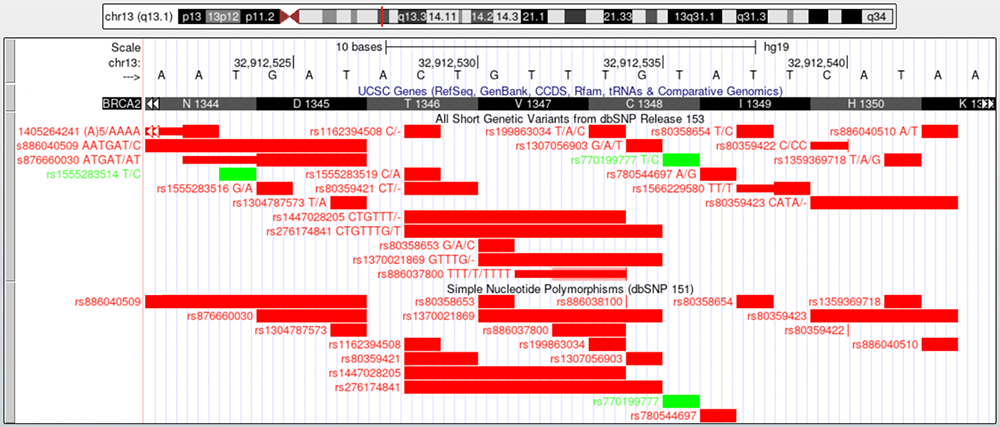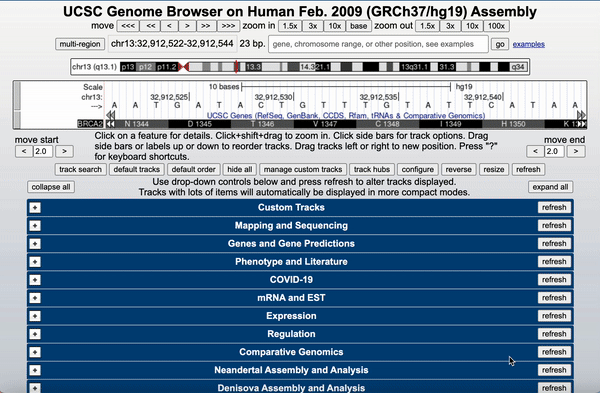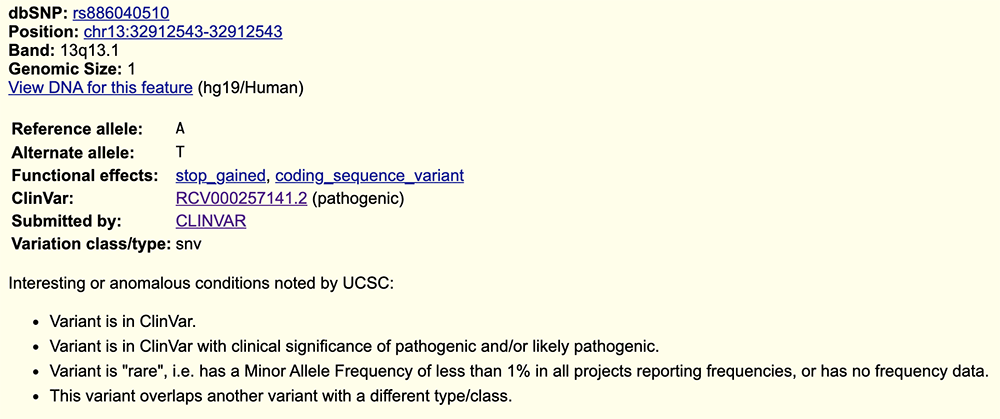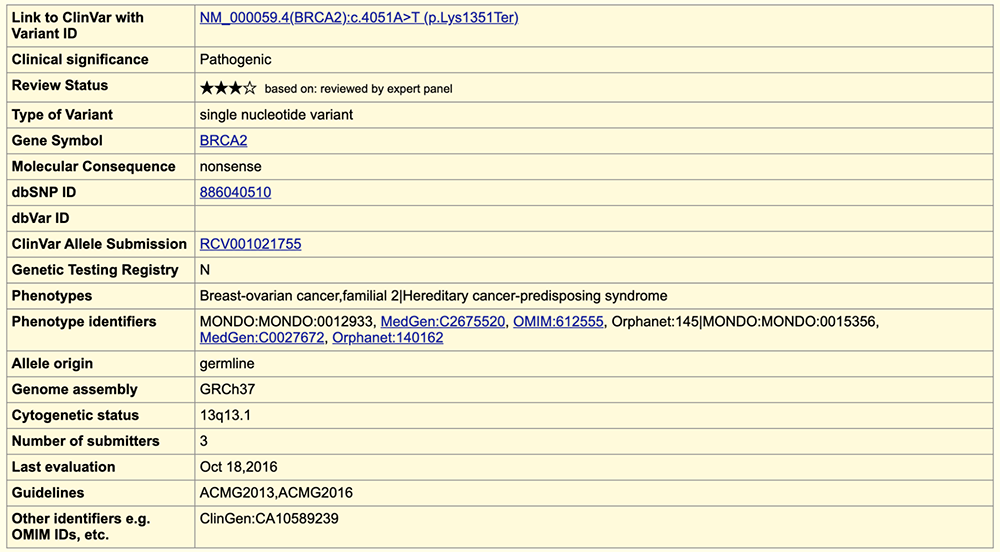- Home
- Genomes
- Genome Browser
- Tools
- Mirrors
- Downloads
- My Data
- Projects
- Help
- About Us
NONSENSE SHORT VARIANTS
INTRODUCTION TO SHORT VARIANTS
Variants are found throughout all of our genomic sequences. In the past, the word "mutations" was typically used in place of "variants," but the present-day nomenclature is the latter, to avoid the negative assoications of the word. Some variants are unique to certain individuals or familial bloodlines ("private" variants), while others are common and well-documented. They can be completely innocuous, or result in faulty proteins with pathogenic ramifications. The Genome Browser can be utilized to visualize variants and their consequences.
A variant is typically defined as a deviation from the sequence of the reference assembly, which itself is the sequence of one arbitrary individual at any genomic location. The gene BRCA2 is known for having variants that are correlated with breast and ovarian cancer because its main function is as a tumor suppressor gene that helps repair damaged DNA; it also has a plethora of potential variations and serves as a good example for exploring different types of variants. We can examine some of these variations by turning on two types of "dbSNP" tracks, both of which tag variation sites in a gene. "SNP" is an acronym for "Single Nucleotide Polymorphism", and has been replaced by the more accurate "SNV" (Single Nucleotide Variant) to avoid misrepresenting the allele frequency — "polymorphism" implies that a variant is common in the population, which is not usually true. The database is still called dbSNP, however.
In Figures 1 and 2, the "UCSC Genes" track is displaying exon 11 of the BRCA2 gene. Below the "UCSC Genes" track are two "dbSNP" tracks, "dbSNP153" (upper) and "dbSNP151" (lower); these two tracks are different iterations of the same rsIDs and data, with some differences between the two data releases. The two tracks have different details available when clicking on one track or the other. Checking both versions of the rsID, or "reference SNP" can provide a wide range of insight into a variant.
Each colored box, labeled with an rsID, note marks a documented variation site within the sequence. A green box indicates that the variant is synonymous, or does not change the resulting amino acid. Red boxes signify that the nucleotide change does impact the amino acid sequence.

Figure 1. Zoomed-in picture of BRCA2, exon 11 (frame is 23 nucleotides across). The DNA sequence is at the top. The "UCSC Genes" track shows corresponding amino acids. The lower tracks labeled, "All Short Genetic Variants from dbSNP Release 153" and "Simple Nucleotide Polymorphisms (dbSNP 151)", have show identified variant sites.
An active Browser session for this view can be found at  https://genome.ucsc.edu/s/education/hg19_BRCA2variants
https://genome.ucsc.edu/s/education/hg19_BRCA2variants

Figure 2. How to enable the "dbSNP 153" and "dbSNP151" on human genome assembly hg19. The "UCSC Genes" track shows exon 11 of BRCA2.
NONSENSE SHORT VARIANTS
Nonsense variations occur when the alternate allele results in a premature stop codon, resulting in a shortened amino acid chain. Figure 3 illustrates an example of a nonsense variant, rs886040510. The reference sequence reads AAA which is translated into a lysine amino acid (or "K"). However, the alternate allele would adjust the codon to read as TAA, which is a stop codon. When read, transcription will halt and the resulting mRNA strand will code for a shortened amino acid chain and therefore an incomplete protein.

Figure 3.
(
 https://genome.ucsc.edu/s/education/hg19_BRCA2stopgain)
Highlighted in turquoise is rs886040510 A/T (A to T change), seen on both "dbSNP153" and "dbSNP 151."
Follow the highlight up to see the corresponding reference nucleotide (A). The black box marks which codon includes the highlighted A allele.
Below, the "UCSC Genes Track" shows the amino acid (K, Lysine 1351) that is encoded by the codon boxed in black.
https://genome.ucsc.edu/s/education/hg19_BRCA2stopgain)
Highlighted in turquoise is rs886040510 A/T (A to T change), seen on both "dbSNP153" and "dbSNP 151."
Follow the highlight up to see the corresponding reference nucleotide (A). The black box marks which codon includes the highlighted A allele.
Below, the "UCSC Genes Track" shows the amino acid (K, Lysine 1351) that is encoded by the codon boxed in black.
Figure 4 shows the "dbSNP 153" details page for this variant. This details page of rs886040510 shows the usual useful information, including the "Functional effects" confirming it as a stop-gained variant, but noteworthy to this varirant is its "ClinVar" status as pathogenic. While the missense variant example did not have any known pathogenic consequences, this allele change is associated with potential diseases; this is not unusual for nonsense variants. Clicking the link on the "ClinVar" line will bring you to ClinVar's data that links the rsID in question to pathogenic phenotypes.

Figure 4. "dbSNP 153" details page of
 rs886040510.
rs886040510.
Another way to see this information is by enabling the "ClinVar Variants" track (under "Phenotype and Literature") on the Genome Browser. Figure 5 shows the Genome Browser with the dbSNP and ClinVar tracks enabled. The turquoise column shows that ClinVar also has an rsID for the same variant dbSNP does. The red box on the "ClinVar Short Variants < 50bp" track is ClinVar's marker of the variant, and clicking on this box will bring you to a details page. The red bead on the top level (P) of the "ClinVar SNVs submitted interpretations and evidence" track is the Browser's way of marking pathogenic variants in ClinVar.

Figure 5.
 https://genome.ucsc.edu/s/education/hg19_BRCA2stopclinvar.
Two "ClinVar Variants" sub-tracks are up: "ClinVar Short Variants < 50bp" and
"ClinVar SNVs submitted interpretations and evidence". The turquoise highlighted column is the variant in question.
https://genome.ucsc.edu/s/education/hg19_BRCA2stopclinvar.
Two "ClinVar Variants" sub-tracks are up: "ClinVar Short Variants < 50bp" and
"ClinVar SNVs submitted interpretations and evidence". The turquoise highlighted column is the variant in question.
Clicking into the variant's ClinVar rsID annotation will provide further information on from ClinVar's data regarding the allele change. This brings one to the page shown in Figure 6 which reiterates previous information we have discovered about this variant, but it also supplies new details regarding the phenotypes associated with an allele change in this position of the genomic sequence. Next to "Phenotypes,", this variant is labeled as correlated with the development of "breast-ovarian cancer" and "hereditary cancer-predisposing syndrome", which is what BRCA2 is well known for.

Figure 6. Details page for the
" A>T
" red box (highlighted in turquoise on figure 11) found on the "ClinVar Short Variants <
50bp" track.
A>T
" red box (highlighted in turquoise on figure 11) found on the "ClinVar Short Variants <
50bp" track.
Written by Zoë Shmidt, UCSC. Major: BA, Biological Anthropology